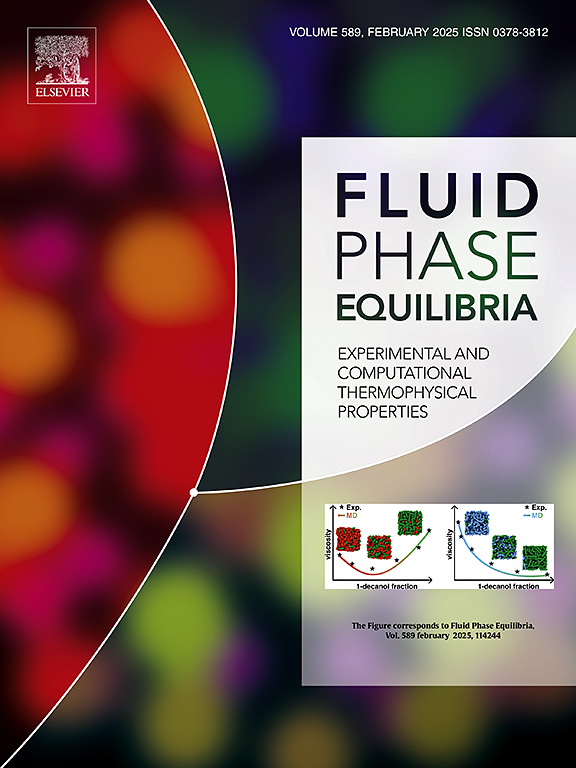水+异丁醇/正丁醇+异丁醛/正丁醛混合物的汽液平衡和液液平衡
IF 2.7
3区 工程技术
Q3 CHEMISTRY, PHYSICAL
引用次数: 0
摘要
从甲醛和丁醇中生产含氧丁醛提出了从含有水和丁醇的混合物中纯化丁醛的挑战,这些混合物具有二元和三元混相间隙。我们给出了二元体系(水+异丁醛)和三元体系(水+正丁醇+正丁醛)在273 K和353 K之间液-液平衡的测量数据。此外,在35 kPa和95 kPa范围内,报告了系统(异丁醇+异丁醛)和(正丁醇+正丁醛)等压二元汽液平衡的测量数据。在383 ~ 450 K之间测量了异丁醛和正丁醛的纯组分蒸气压。建立了一个UNIQUAC模型来预测三元体系(水+丁醇+丁醛)的气液拓扑结构。这允许确定丁醛作为技术上最相关的原料的可获得的蒸馏产品。本文章由计算机程序翻译,如有差异,请以英文原文为准。

Vapor–liquid and liquid–liquid equilibrium in mixtures of water + isobutanol/n-butanol + isobutylal/n-butylal
Producing the oxygenate butylal from formaldehyde and butanol presents the challenge of purifying butylal from mixtures also containing water and butanol, which exhibit both binary and ternary miscibility gaps. We present measurement data on the liquid–liquid equilibrium in the binary systems (water + isobutylal) and (water + n-butylal) as well as in the ternary system (water + n-butanol + n-butylal) between 273 K and 353 K. Additionally, measurement data on the isobaric binary vapor–liquid equilibrium in the systems (isobutanol + isobutylal) and (n-butanol + n-butylal) is reported between 35 kPa and 95 kPa. The pure component vapor pressures of isobutylal and n-butylal are measured between 383 K and 450 K. A UNIQUAC model is developed to predict the vapor–liquid topology of the ternary system (water + butanol + butylal). This allows for identifying butylal as an obtainable distillation product for the most technically relevant feeds.
求助全文
通过发布文献求助,成功后即可免费获取论文全文。
去求助
来源期刊

Fluid Phase Equilibria
工程技术-工程:化工
CiteScore
5.30
自引率
15.40%
发文量
223
审稿时长
53 days
期刊介绍:
Fluid Phase Equilibria publishes high-quality papers dealing with experimental, theoretical, and applied research related to equilibrium and transport properties of fluids, solids, and interfaces. Subjects of interest include physical/phase and chemical equilibria; equilibrium and nonequilibrium thermophysical properties; fundamental thermodynamic relations; and stability. The systems central to the journal include pure substances and mixtures of organic and inorganic materials, including polymers, biochemicals, and surfactants with sufficient characterization of composition and purity for the results to be reproduced. Alloys are of interest only when thermodynamic studies are included, purely material studies will not be considered. In all cases, authors are expected to provide physical or chemical interpretations of the results.
Experimental research can include measurements under all conditions of temperature, pressure, and composition, including critical and supercritical. Measurements are to be associated with systems and conditions of fundamental or applied interest, and may not be only a collection of routine data, such as physical property or solubility measurements at limited pressures and temperatures close to ambient, or surfactant studies focussed strictly on micellisation or micelle structure. Papers reporting common data must be accompanied by new physical insights and/or contemporary or new theory or techniques.
 求助内容:
求助内容: 应助结果提醒方式:
应助结果提醒方式:


